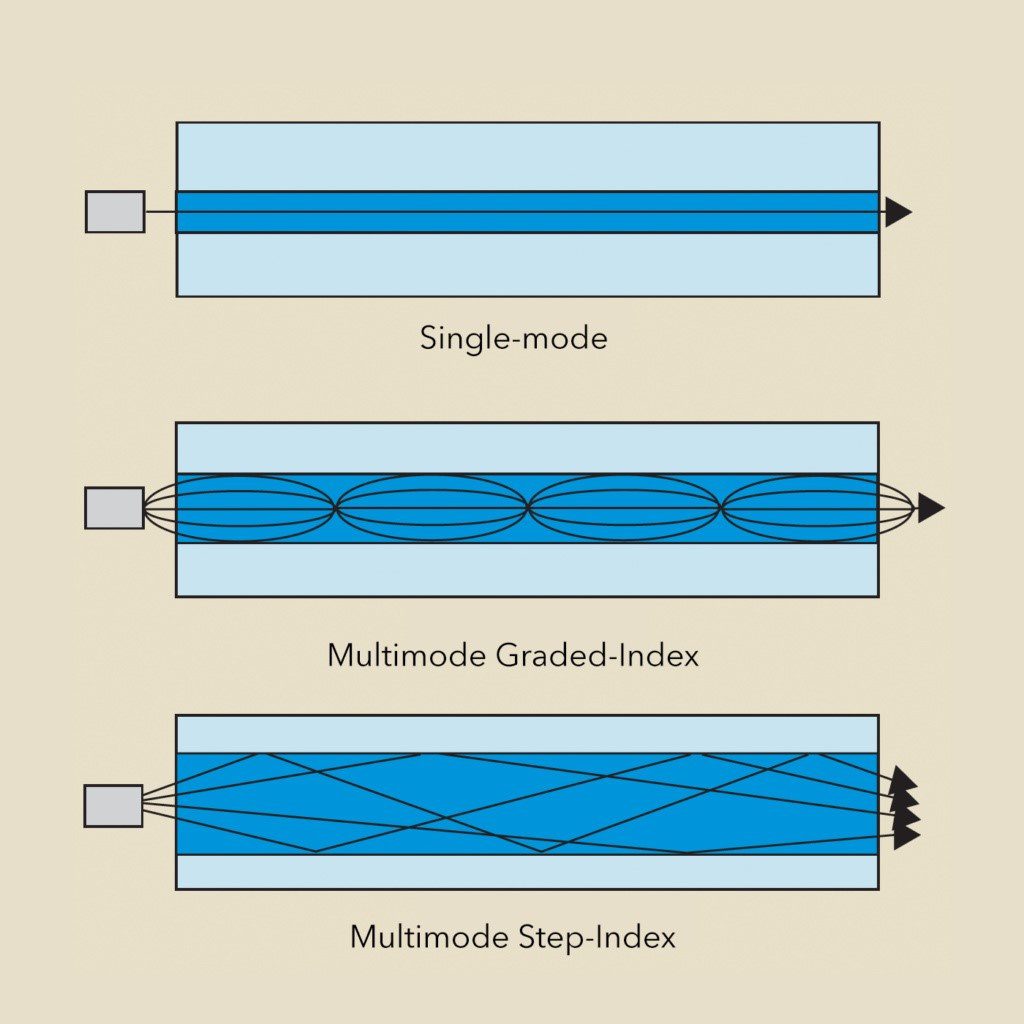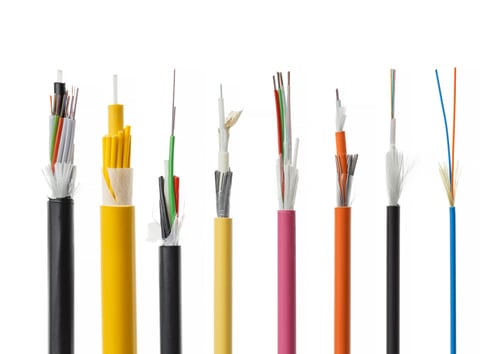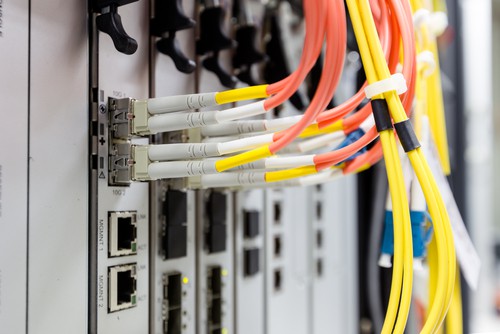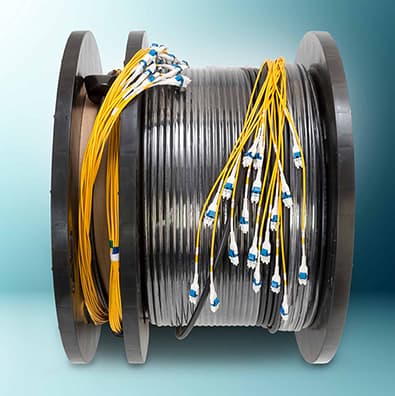How Do Communications Fiber Optic Cables Work?
How Do Communications Fiber Optic Cables Work?
TLDR: In communications fiber optic cables, light is introduced into the core of an optical fiber via a light source (LED, Laser Diode). The light rays reflect off the outer walls of the core (the cladding layer) until they reach the other end of the fiber where a light-sensing receiver converts the pulses into digital ones and zeros.
How do fiber optic communications cables really work?
At its most basic, a communications optical fiber cable is composed of glass strands, like threads, about the diameter of human hair, each of which can transmit messages modulated onto light waves at the speed of light. They offer greater bandwidth than copper wire cable and have become the go-to option to meet the demands of the age of the internet where large amounts of data (e.g., streaming apps) must be distributed to thousands of subscribers, miles away and instantaneously.
he first step to understanding how fiber optic works is to understand what happens when you send light through air or water. Light travels as a wave. When it passes through the air, the wave loses some energy and becomes more spread out. The result is that the light beam gets wider and less intense. This loss of intensity is called attenuation.
When light enters the water, however, it does not lose any energy. Instead, it bends around the water molecules, making it easier for the light to pass through. Water also slows down the light’s velocity by a factor of 1/v2 where v is the speed of light in water. This means that light traveling through water will travel farther than if it were traveling through air. Optical fibers use these principles to carry data from one point to another.

Most optical fibers in use today consist of glass strands (the core) made of pure silica surrounded by cladding material made of doped silica. The core is so small that only a single ray of light at a particular wavelength can travel through to the end. These are called single-mode fibers. In this design, the cladding layer has a lower refractive index and acts like a mirror to keep the mode inside the core. This phenomenon is known as total internal reflection.
The performance of optical fibers depends on how well they can transmit light. One way to measure this is by measuring the return loss (also called insertion loss) of the fiber. Return loss is defined as the ratio between the power in the forward direction and the power in the reverse direction. If the return loss is high, more light will be lost when traveling through the fiber than if the return loss was low.
Advantages of Fiber Optic Cables
Optical fibers have many advantages over traditional copper wires:
1. Faster data transfer speeds: Fiber optic cables are able to carry much more information than traditional copper wires, at significantly faster speeds. This makes it ideal for applications that require reliable, high-speed data transmissions—such as streaming video or internet services.
2. More Bandwidth: Fiber optic cables are capable of carrying a wide range of frequencies in both directions simultaneously, known as multiplexing. This allows more data to be transmitted over the same wavelength, providing even more bandwidth capabilities.
3. Less Loss of Data: A single fiber optic cable is able to transmit signals with very minimal loss or attenuation, making them ideal for long-distance installations and large-scale service networks.
4. Immunity to Interference: As light passes through the glass fibers in a cable, there is little interference from external electrical fields or noise sources such as radar or EMI (electromagnetic interference). This makes them compatible with high-frequency transmissions such as satellite communications systems and cell phone towers.
5. Improved Security: Fiber optic cables are also extremely secure because it is nearly impossible for anyone to intercept their signal without physically cutting into the cable itself – something that would be quickly noticed!

There are 2 basic types of fibers, single mode and multimode. Single-mode optical fiber is smaller in core diameter (8.3-10 microns) and holds advantages in terms of bandwidth and reach for longer distances, while multimode optical fibers have larger core diameters (50 microns or larger) and easily support most distances required in enterprise and data center networks, at a cost typically less than single-mode installations.
Optical fiber technology is used in many ways today. It is used for transmitting voice and video signals, carrying computer data, and for sending information across long distances.
Optical fibers are used to manufacture endoscopes which allow doctors to view inside the human body and perform surgery without the need for invasive scalpel procedures. Large core fibers can carry laser energy to facilitate the removal of tattoos, the cleaning of historical monuments, and the powering of laser-directed defense systems.
Distributed fiber optic sensing (DFOS) allows for the entire length of an optical fiber to be used as a sensing device. Structures like fuel pipelines, bridges, and aircraft wings can have optical fibers embedded into them to detect such parameters as strain, temperature or sound and help ensure their structural integrity.
Source https://www.ofsoptics.com/faq-guide-to-fiber-optic-cable/how-do-communications-fiber-optic-cables-work/
What Is Fiber Optics Used For?
Fiber optic cables were originally developed in the 1950s for endoscopes. The purpose was to help doctors view the inside of a human patient without major surgery. In the 1960s, telephone engineers found a way to use the same technology to transmit and receive telephone calls at the “speed of light”. That is about 186,000 miles per second in a vacuum, but slows to about two-thirds of this speed in a cable. So, what are fiber optics used for? In a nutshell, for signal transmission, communication and vision (video).
How Does a Fiber Optic Cable Work?
Light travels down a fiber optic cable by bouncing off the walls of the cable repeatedly. Each light particle (photon) bounces down the pipe with continued internal mirror-like reflection.
The light beam travels down the core of the cable. The core is the middle of the cable and the glass structure. The cladding is another layer of glass wrapped around the core. Cladding is there to keep the light signals inside the core.
Types of Fiber Optics Cables

Various types of fiber optic cables
There are many types of fiber optic cables, often that end up in fiber optic cable assemblies to execute their function.
Single And Multimode Fiber
Fiber optic cables carry light signals in modes. A mode is a path that the light beam follows when traveling down the fiber. There are single mode and multimode fiber cables.
Single mode fiber is the simplest structure. It contains a very thin core, and all signals travel straight down the middle without bouncing off the edges. Single mode fiber optic cables are typically used for CATV, Internet, and telephone applications, where the signals are carried by single mode fibers wrapped into a bundle.

Multimode fiber optic cables are used as patch cords or “jumpers” to interconnect data equipment
Multimode fiber is the other type of fiber optic cable. It is about 10 times larger than a single mode cable. The light beams can travel though the core by following a variety of different paths, or in multiple different modes. These cable types can only send data over short distances. Therefore, they are used, among other applications, for interconnecting computer networks.
There are four types of multimode fiber optic cables, identified by “OM” (optical multimode). An industry association designated them as OM1, OM2, OM3 and OM4. They are described by ISO/IEC 11801. OM4’s standard was approved by TIA/EIA 492AAAD. Each OM has a minimum Modal Bandwidth requirement.
Plenum
In addition, fiber optic cables can be made to comply with industry standard requirements for installation in air plenums. These are used inside buildings with special materials and compounds for jacketing. Called “plenum cables,” these meet flame and toxicity requirements in the event of fire.
Simplex And Duplex Optical Fiber
Simplex fiber optic cable constructions contain a single strand of glass. Most often, simplex fiber is used where only a single transmit and/or receive line is required between devices or when a multiplex data signal is used (bi-directional communication over a single fiber).
A duplex fiber cable consists of two strands of glass or plastic

Fiber Optic Cable on Crate Reel, with Pre-terminated ends
fiber. Typically found in a “zip cord” construction format, this cable is most often used for duplex communication between devices where a separate transmit and receive are required.
Other Applications Of Optical Fiber Technology
Besides plenum cable constructions, fiber optic cable assembly manufacturers create:
- “Siamese” structures (two cables side by side, each with its own jacket)
- hybrid cables (with copper cables)
- bundled and composite cable constructions that include other fiber optic, copper, or sometimes power pair cables
Shorter “patch cables” or “fiber jumpers” are used to interconnect various pieces of electronic equipment in a server room, telco closet or data center.
Uses of Optical Fiber in Our Daily Life
What are optical fibers used for? You may have seen plastic fibers carrying colored lights in decorative applications. What you may not have seen are the real glass fiber optic cables that are now the foundation of our communication and computer networks. Many thousands of miles of installed fiber optic cable carry many types of information underground, in tunnels, building walls, ceilings, and other places you don’t see. For examples of uses of optical fiber in our daily life include applications such as:
- computer networking
- broadcasting
- medical scanning
- military equipment
In recent years, other fiber optic uses have arisen. Fiber optic cables have become the backbone for MANs, WANs and LANs. There has been a trend toward “FTTX” or “Fiber to the XXXX” applications. That is, for example, Fiber to the:
- Home (FTTH)
- Curb (FTTC)
- Premise (FTTP)
- Building (FTTB)
- Node (FTTN)
Initially, fiber optic uses were primarily trunk cable lines designed to carry signals to larger populated areas. Over time, these cables have extended their reach to the home, the building, etc.,
Source 2 https://www.nai-group.com/optical-fiber-technology-how-it-works/


Comments
Post a Comment